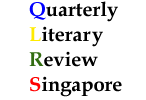 |
 |
|||||||||||||
|
The ‘Eking’ of Meaning: Reading Within and Between Warped Lines
By Jonathan Chan
Eke The poems of Wahidah Tambee's Eke are not intuitive to the eye. Eke is a book of visual poems. They defy a conventional form of horizontal reading, presented as they are with letters hanging or slightly dislodged, beyond being arranged in lines. The poems are presented beyond the bounds of ordinary lineation. Wahidah's poems are to be read sideways, vertically and diagonally. Two letters may rest atop one another, in between two other letters, opening the possibilities of wordplay and opportunities for multiple readings. Take the poem 'moodlet', for example:
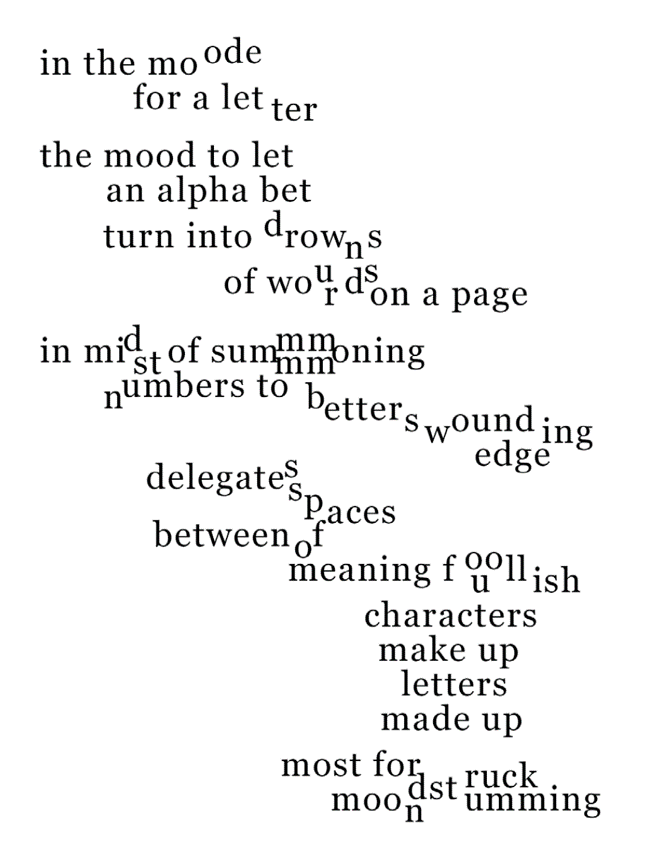 The poem's title 'moodlet' guides the eye to 'mo', 'od', and 'let', three pairs of letters hovering around one another. One might start thinking "in the mood / for a letter", but the eye is drawn equally to the word "ode". Below, the letters of "drowns", "wounds" and "words" seem to be jumbled up, almost as if each is floating or suspended, as if to invite the reading and rereading of each letter accordingly. This happens again in the line that follows – the clump of letters forming "sound", "wound", "sounding", "wounding", "edge", then "full", "foolish", "foulish". Its conclusion contains a thesis of sorts, how "characters / make up / letters / made up / most for", before the multiple reading of "mood", "moonstruck", "strumming". The poem perhaps prioritises individual images less and more its own act of composition, its visual representation reflecting its own description – one might argue that the letters formed into words are drowning, or as if they are jumbled as a result of their wounding. Spaces are delegated to each letter, but the letters as delegates seem to pace across the page. The juxtaposition of "foolish", "fullish" and "foolish" could each be read as descriptions of a reader's emotional response to the poem, perhaps a confusion over a perceived juvenility of the wordplay, or a sense of incompleteness, or even a visceral sense of such wordplay being "foul" to the brain. The poem's conclusion meshes a response of feeling struck by the poem's particular mood, perhaps of playfulness, of being "moonstruck", evocative of "awe", or even the "strumming" of letters into new arrangements, like several strings played like a guitar chord. The effect of this is perhaps a kind of disorientation, a training of the eye to consider the various overlapping words and meanings embedded in the poem itself, the shape of the poems informing the process of interpretation at the level of semantics. In live readings of the poem, Wahidah provides one such way of approaching the poem, replete with echoes and responses, with one reading sounding to the ear as such:
Each possibility is carefully sounded and teased out in such a rendering, with attention given to the full possibility of the poem's wordplay as demarcated on the page. It is a poetics that demands repeated and simultaneous readings, the eye trained almost as one reads a crossword puzzle, looking for new words out of the careful placement of each letter. Attention rests, therefore, not only on sound or image, but also on semantics and wordplay. There is an attention to the pressures of etymology and meaning, the slippage that occurs with the exchanging of one or two letters. 'moodlet' is one example of the various poems that compose Eke. The collection finds its origins in Wahidah's Master of Arts thesis as a graduate student at Nanyang Technological University. Eke, as Wahidah writes, "begins with the problem of expression", its visual poems "investigating how thoughts, feelings, and personal histories interfere with the process of expression". To these ends, the displacements of words and letters in fragments, as she writes, is to form "obstructions" that enact the "fumble(s)" and "stammer(s)" of expression, as she borrows from Roland Barthes in A Lover's Discourse, the representation of a struggle cognitively, intellectually, emotionally and physically. The poems' semantic and visual ambiguity demand that the eye is "split open", a notion Wahidah borrows from the language poet Charles Bernstein. Drawing on her training in psychology, Wahidah cites psychologists Kiel Christianson, Steven G. Luke, Erika K. Hussey and Kacey L. Wochna, who observe an increase in how the eye moves backward rather than forward in the text when forward reading is disrupted. This is a result of difficulty in "integrating incoming material". Wahidah refers to poets such as the French modernist Guillaume Apollinaire, French-Norwegian poet and sound artist Caroline Bergvall, the perennial concrete poet e. e. cummings, the ubiquitous Derrida and Saussure, and scholar of multimodal cognitive poetics Mike Borkent, as well as the Canadian poet bpNichol, each of whom present and interrogate pressures of meaning, interpretation, legibility/illegibility, multiplicity and meaning. Each provides the intellectual scaffolding for Eke with Wahidah examining the act of meaning-making and indeterminacy through the psychological paralysis of utterance. The poetics of Divya Victor, interested in trauma and formal experimentation, also bear some influence, though Victor is addressed explicitly given Wahidah having been under her tutelage for her project. This intellectual and conceptual lineage, however, is not addressed explicitly in Eke but rather is outlined in Wahidah's MA thesis itself. Eke draws heavily on Bergvall's article 'A Cat in the Throat', in which bilingualism and multilingualism highlight "conflicts and contradictory feelings of both belonging and dislocation in the throat of the speaker". Such a schema provides a more proximate framework for the "intellectual dilemmas of the post-colonial, multilingual voice", in which Wahidah's subjectivity is situated. As she describes, "Even as I go along the trail I discover that neither English, Arabic, Tamil or Malay are mine." There is a sense of the absence of such subjectivity in relation to many of these poets, psychologists, and sound artists, their interrogations of language seemingly operating in contexts far removed from Singapore, or the self in Singapore, primarily within a European epistemological frame. Wahidah's own subjectivity is shaped by her Muslim faith, her Indian and Malay heritage, and her Anglophone writing and speech. In Eke, one sees the fruits of Wahidah's meticulous research, in service of finding and grasping for adequate conceptual parameters against which to examine her thoughts and feelings held by a "cat in the throat", described otherwise as a "plasma state", a permanent position of divergence, diversion and oscillation. It may be instructive to examine several more poems in the collection. One could place Wahidah in relation to writers and artists beyond those cited in her thesis, including Susan Howe, known for her innovative verse forms; M. NourbeSe Philip, for her lucid and haunting visual poem Zong! (2008); Layli Long Soldier, whose poems are invitations for multiple orders of reading as in the poem 'Obligations 2'; or even the transformative poetics of Theresa Cha's Dictée (1982). While Wahidah has identified in her thesis pairings and clusters of poems that speak to one another, several stood out to me for their mesmeric quality, each enacting their own sort of semantic sleight-of-hand. Take, for example, the consecutive poems 'dismissile' and 'erasuredust':
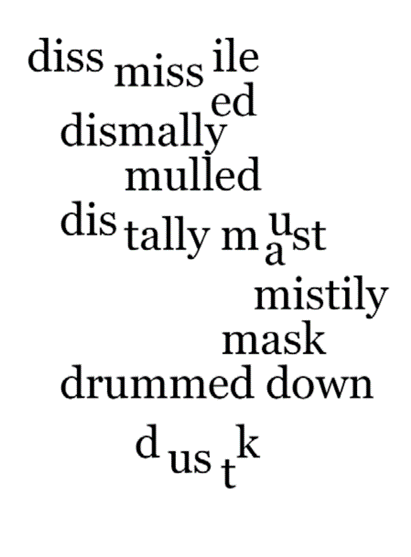 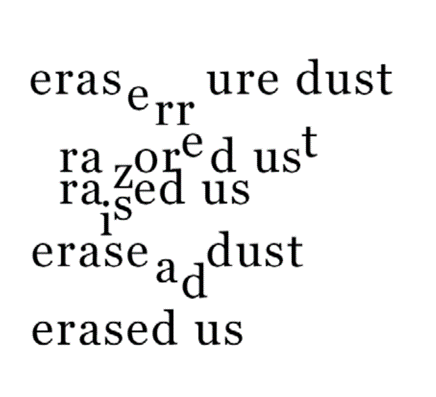 As with 'moodlet', each poem presents the ideas of divergence, diversion and oscillation, through the multiplicity of readings the placement of their letters encourages. "dismissile" is a portmanteau – the poem plays with the words "diss", "dismiss", "missile", "dismissed", before moving to "dismally", "mulled", "must/mast", "drummed down", "dust/dusk". It is the word "missile" on which the conceit of the poem seems to hinge: is being dismissed akin to having a missile shot at oneself? Does the detritus of a missile attack at "dusk" leave only "dust"? In 'erasuredust', the poem seems to pick up directly from 'dismissile', with the words "erasure", "eraser", "dust", "razored", "razed", "raised" and finally "erased us" swirling and congealing into one another. Destruction and cultivation lie alongside one another in the same semantic plane between "razed" and "raised", but the ultimate "erasure" of the speaker to "dust" is presented even more starkly with the line "erased us". These various ideas of removal, eradication and deletion seem to reinforce one another before the poem comes to its more explicit conclusion. The poem that follows these two, 'dustlies', picks up again the image of "dust", albeit from a place of seeming resignation, with the phrases "dust lie" and "does lie" alternating between one another, forming a kind of tortured semantic satiation, words seeming to lose their meaning with each repetition:
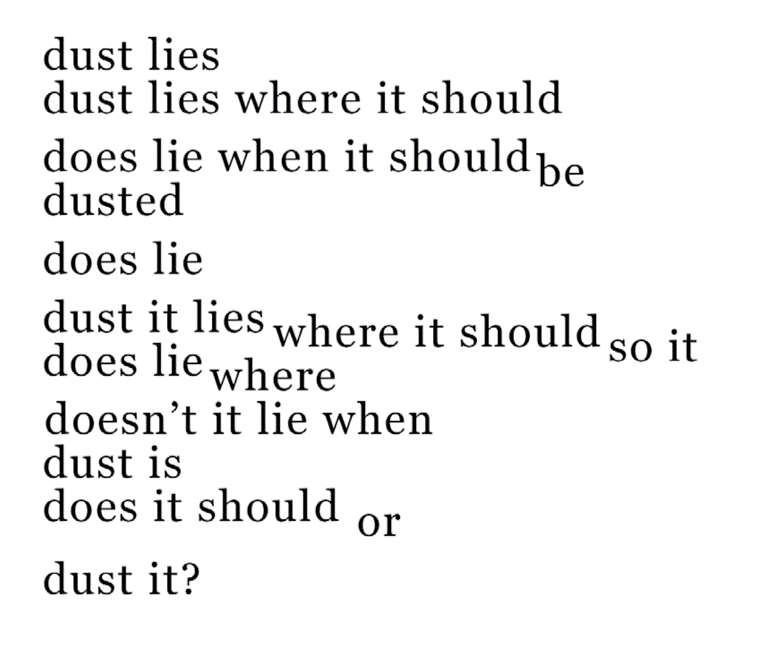 In other poems, the problems of meaning and articulation are brought more strongly to the fore. The previous three seem to suggest the "fumble" and "stammer" as responses to a kind of pulverising of the speaker's confidence. Wahidah writes in her thesis of being ambivalent of being referred to by a teacher as "very careful and very cautious" when sharing opinions in a class, perhaps reflected in the preceding poems. The poems 'bias seem binding', 'impluie', and 'said sail' home in on the very problem of expression itself. In 'bias seem binding', the persona speaks, seemingly in media res:
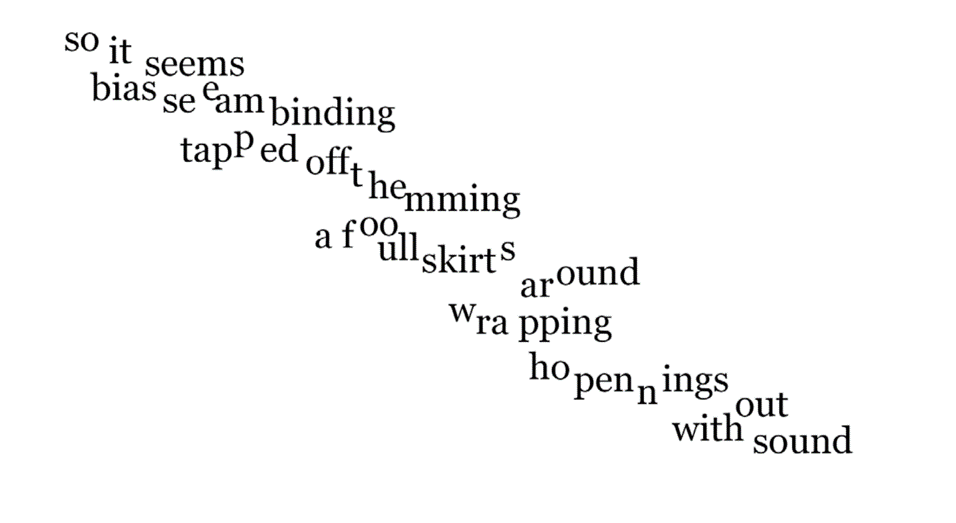 The poem proceeds from "so", the interjection or beginnings of a thought, perhaps. The word that lends momentum to the poem is "bias", evocative of a prejudice that somehow seems to have a suturing function, creating a sense of fixture. Present in the poem is a textile motif: "seam", "binding", "hemming", "skirt". Does a sense of bias draw together these disparate elements? "hope", "openings", and "pen" are seemingly wrapped "with" and "without" sound. Does bias create a sense of enclosure around possibility? One might make the presumption that this is an intersectional prejudice, if one is to consider Wahidah's ethnicity, gender or linguistic ambivalence. Meaning is imputed both sonically and silently. 'impluie' draws into focus the relationship between articulation and agony:
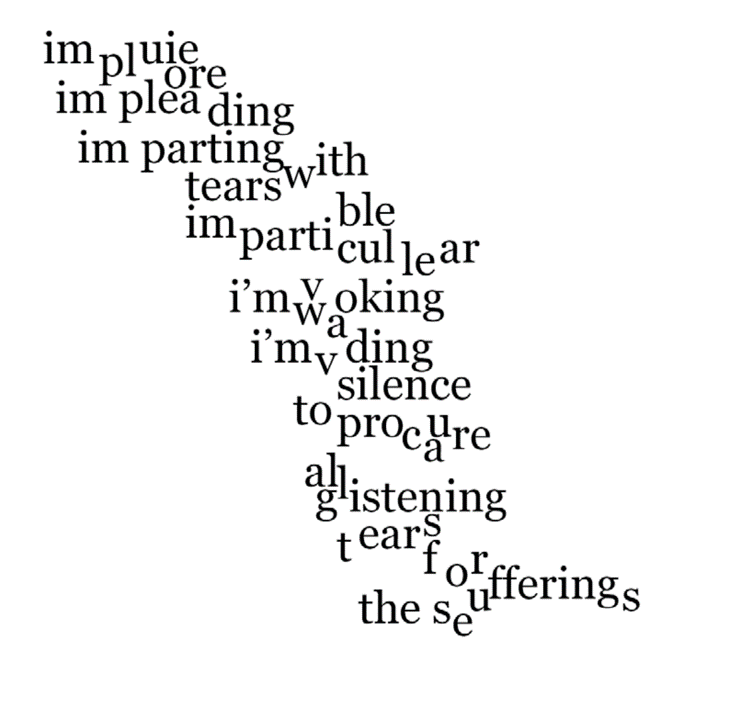 The word "pluie" is French, meaning, variously, rain, a shower, precipitation, a hail of insults, to be experienced, to be boring as rain, or the joy that comes after the rain. The image of rain is linked to the image of "tears". "impluie", another portmanteau, may suggest "I'm pluie", meaning "I'm raining". The poem draws to mind Theresa Cha's Dictée, in her yoking of the sound of rain, or 'La Pluie' (also the title of one of the sections in Dictée), to words like "Exhalation" and "breaths". In Wahidah's 'impluie', there is a melancholy laced through the words "implore", "plea", "pleading", "parting", but also the fact of a precise pain in the "particular". "I'm" becomes the stand-in for the prefix "in-", creating the visual approximation of "invoking" and "invading", despite not actually presenting those words. In silence, there are "glistening / tears" and also "listening / ears" for "these / sufferings". From the persona that begs to the persona that is. Speaking moves to listening, a silence seemingly forced or demanded, a defiance, or a suffering, expressed through tears. In 'said sail', the image of the missile returns to conclude the poem:
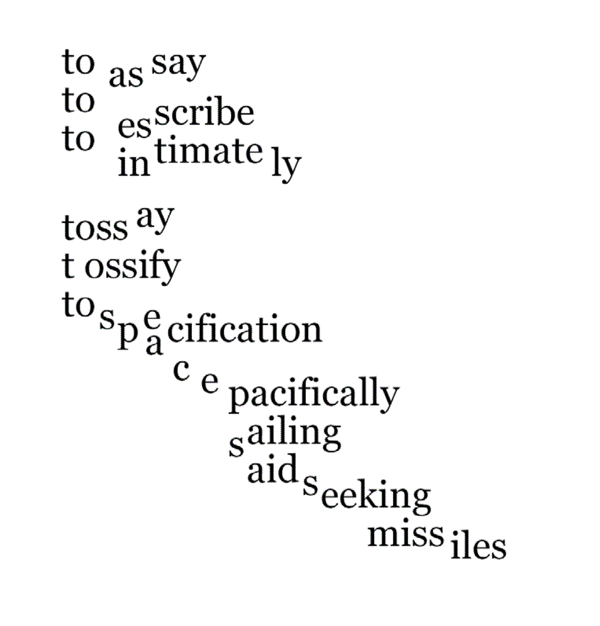 In the word "assay" lies the notion of an attempt, not unlike the word "essay". What is the attempt? To "scribe" suggests to write, to "say" and to "ossify" suggest both the passing and the reification of meaning, "space" and "specification" are two dimensions that linger in each of Wahidah's poems. "sailing", "said", "seeking", "miss" and "missiles" create a return to movement, the eruption again of the imagery of weaponry. The idea of "aid seeking missiles" speaks to a sense of violent contradiction, the inflicting of a wound on a vulnerable target. What remains is a sense of the struggling self, the subjectivity that makes continuous "attempts" at expression. This manifests as the "fumble" and the "stammer", despite the active injunction of "to" before each of the poem's verbs. While perhaps not evident upon first reading, there is also an element of transcendence present in Eke, though it is an approximation, a reaching for a way of communicating with the divine, though the tension between the singularity of religious meaning and the dissolution into poetic fragments in Wahidah's work remains. Wahidah has written as well of an initial misperception of a word being a mere "vehicle for meaning", done once it was delivered. She cites the word "alhamdulillah", initially conceived of only as an expression of gratitude. She writes that it was the correction of a teacher, Ustad Z., that challenged this conception, with "alhamdullilah" referring to "all the praises and thanks conceivable to humankind" as well as the "praises and thanks that lie out of the limit of conceivable thought of humankind", in addition to "the praises that only Allah can confer to Himself". Present is the sense of a maximalist, expansionist meaning, how a word can "extend beyond itself", beyond mortal conception. This is present in the poem 'sacré': 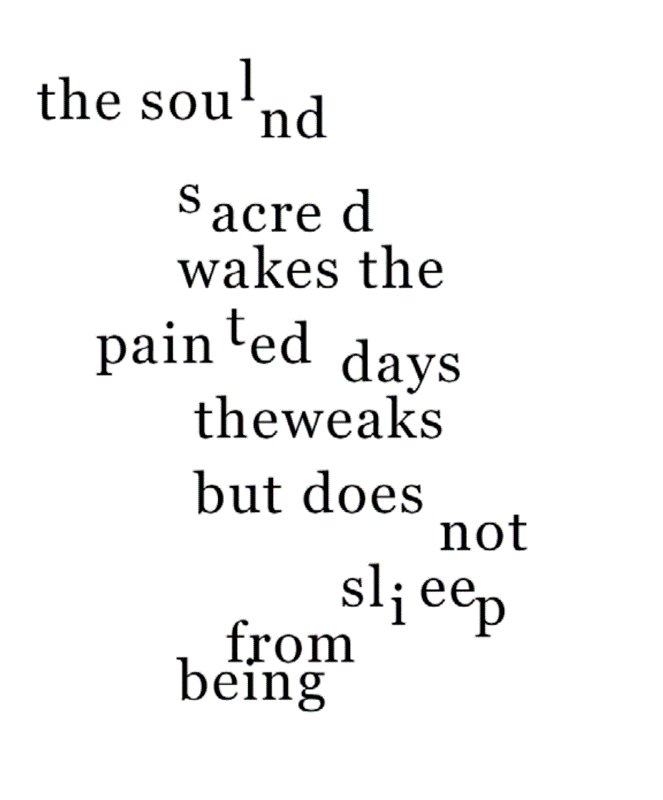 Particularly striking is the fusion of "soul" and "sound" in the poem's first line, preceding, again, a word from the French, "sacré", coming into "sacred". It is the resonance of the deepest, essential part of the individual that leads to the experience of religiosity, preceding the days of "pain" and that are "painted". "weaks" is the stand-in for "weeks", the homonymic juxtaposition of the passage of time and the vulnerability of the body. In her thesis, Wahidah describes how she found it "easier to write about poems about the beauty of nature – the 'aayat' or sign from Allah – by having words be reduced to fragments, being submitted to decay". In Wahidah's conception, word and letter fragmentation are akin to "painterly strokes of the sky", or as she alludes to in 'sacré', the "painted days", as is evident in the poem 'sunrise':
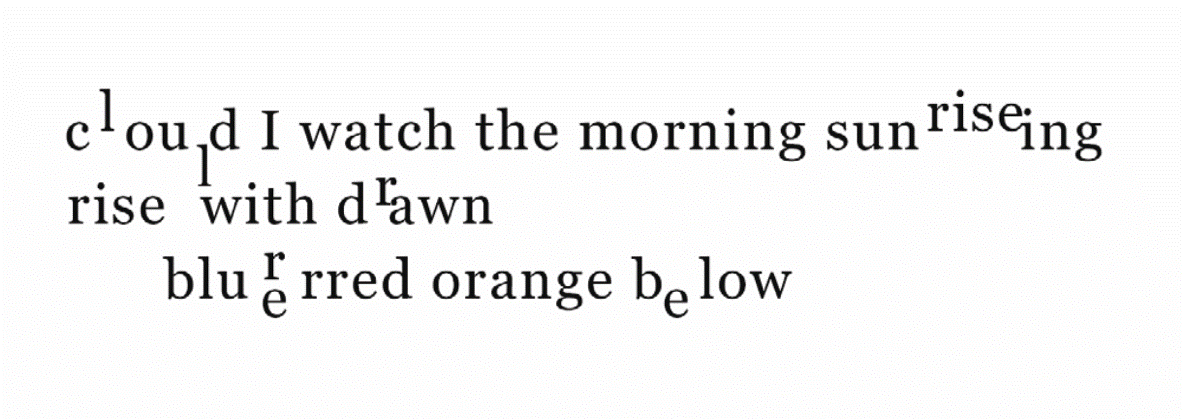 The letter "l" is displaced in the word "cloud", the slightly higher positioning of "rise" between "sunrise" and "riseing" convey a sense of ascension, while the painterly is evoked by the simultaneity of "drawn / dawn". The edges of the clouds, between the blue of evening and orange of the morning, is presented in "blurrred / blue" but also "red orange". As opposed to the poem being merely ekphrastic, descriptive and evocative of a painting or piece of art, or something with an aesthetic quality, the poem itself attempts its own impressionism. Inherent to this is both the permanence of a singular divine beauty, yet also the inadequacy of forms of descriptive precision. These are instances where Wahidah's poems most clearly approximate a kind of visual art, harkening to the aesthetic sense of impressionism through dabs and strokes, albeit in words and letters. 'it moves across' is also attuned to this:
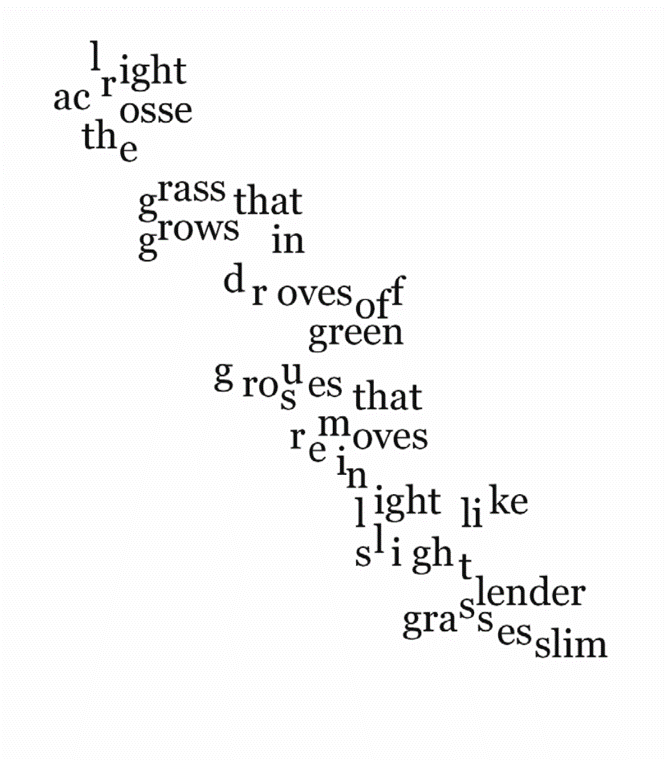 The poem presents a kind of tactility, a sense of the tangible to intangible "light". The movement of the letters from left to right evokes a sense of the kinetic, of light falling on "the grass that grows". The grass falls on "green grouses", on "slight slender grasses", but at the same time "moves" is also read as "removes". There is a sense of procession and recession, advancement and withdrawal. It is not a sheer beam of light that falls upon a dim subject. It resembles, also, the slow arc of light falling during the day, lending gradual brightness to the colour of the fields and grasses. The collection's concluding poem, 'what was i saying', seems a reiteration, or an emphasising, of what seems to be the collection's core conceit: of the unutterable, the disarticulate, the tentative, the halting:
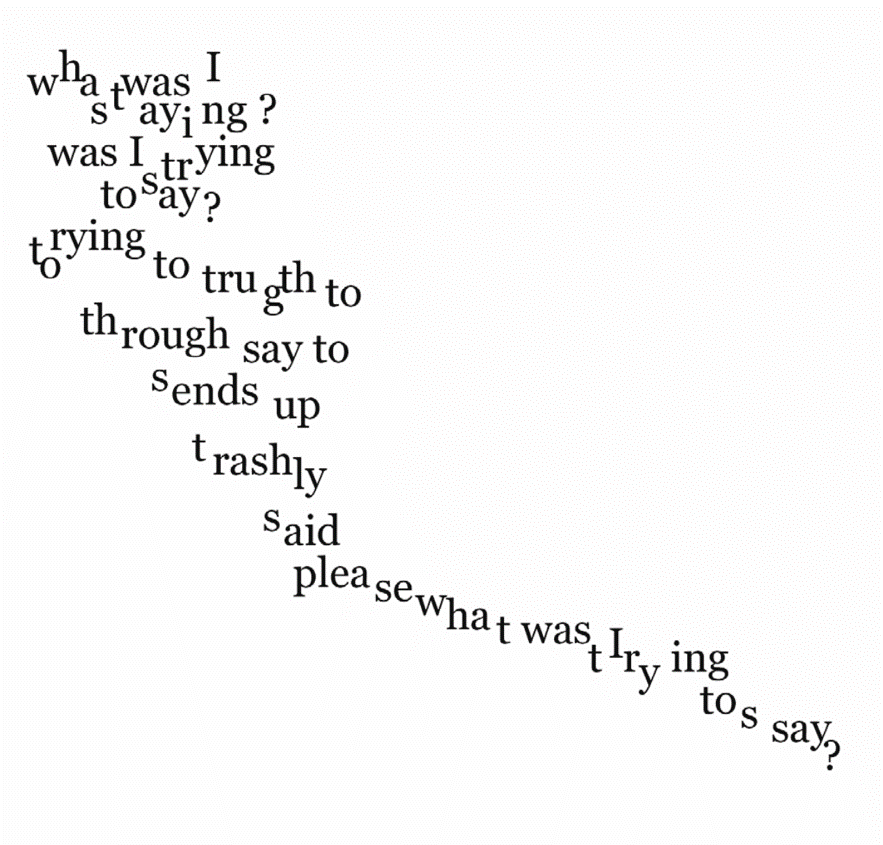 Immediately, the eye is drawn to not only the title of the poem, clumped in the top portion of the poem, but also the juxtaposition of "staying", "straying", "trying", "saying", "say". There is a sense of distraction, of a wavering, of inconclusiveness that lies at the poem's beginning. "to trying", "to truth" lies beneath the attempt of speech itself. The words "trash" and "rashly" suggest an uncertainty towards the words themselves, the irony of perceiving oneself as "rash" amidst the hesitance of the presentation of the poems, of expression as "trash" despite its depth of thought surrounding communication and meaning. There is a suspicion towards the self in "please what was I trying to say?" The suspicion towards fixed meaning is extended to the self, to the expression of the self, to the language used as a vehicle for the meaning of the self. This experience of 'disarticulation' is what draws the collection to its close, weary and wary of what meaning spills forth from its speaker. Wahidah has written of the inadequacy of Microsoft Word in fully realising the poems she intended to write. The poems of Eke could be written only with Adobe Photoshop, allowing for "more freedom to manipulate the text on the page without the distraction of conformity". The "technical freedom" of Photoshop availed the possibilities of playing around with "vertical and horizontal spaces", allowing her to "fork out to possibilities of meaning", to form "word-webs", to "reconfigure the word into a network", to thread "possible meanings". It is a point of technique which provoked in me a sense of the restrictions of word processing applications, whether in Word or its relations. Process-oriented poets are perhaps less common in Singapore; in these regards, Wahidah may find herself in the company of such poets as Joshua Ip, Hamid Roslan and Tse Hao Guang, whether that process is shaped by tools (Photoshop or Large Language Models), prompts (inspired by Oulipo exercises), or other forms of visual presentation. It is no surprise, therefore, that some of the poems of Eke found a place in Tse's journal OF ZOOS. Beyond the pages of a printed and bound collection, one may well imagine Wahidah's poems within the context of a gallery, hung and presented for a viewer, drawn to the possibilities of their visual presentation. Just as Wahidah's are poems of exhausted meaning, they are also poems of typographical intrigue, tantalising in their construction, splitting, stretching and suturing words and letters. Notably, Eke is the first collection of poetry published by Gaudy Boy that is not a winner of its eponymous Gaudy Boy Poetry Book Prize, but a finalist. The very title of the collection, Eke, contains the sum of Wahidah's thinking, described as "in its brevity and symmetry", representing "talking with a cat in the throat". It is a homonym and anagram of the sound "eek", a "frightened squeak" and a "sound of brief fear", which contrasts to the individual trying to "eke out limited resources" of "calm and containment" in response. Wahidah brings her collection to an end with an 'Afterword', concluding:
Eke's forms and concerns distinguish it from many of its contemporaries in Singapore and elsewhere. The 'eking' of meaning, of resolve, of expression underscores a poetics of indeterminacy, of the slipperiness of meaning, and the problems of disarticulation. Wahidah's struggle is an invitation, or a beckoning, to those to partake in this act of parsing meaning, not merely imagistically or lyrically, but visually and semantically. What are the possibilities of reading that her poem allows, directionally, emotionally, linguistically? These are not poems for the impatient, nor those who make straightforward demands of reading poetry. Note: The quoted poems, making up only a fraction of the book, are reproduced from Eke with the permission of the publisher, Gaudy Boy. QLRS Vol. 24 No. 3 Jul 2025_____
|
|
|||||||||||||
Copyright © 2001-2025 The Authors
Privacy Policy | Terms of Use |
E-mail